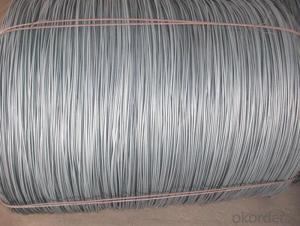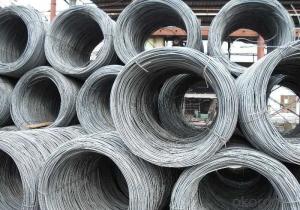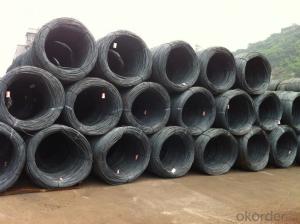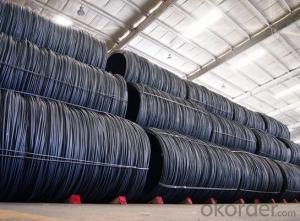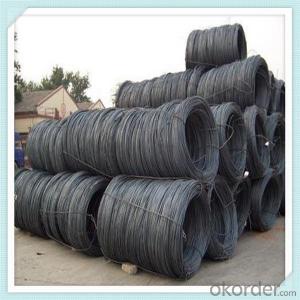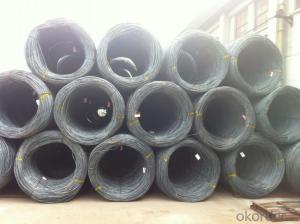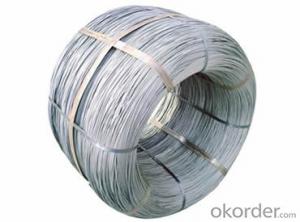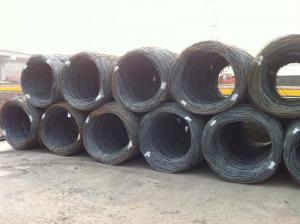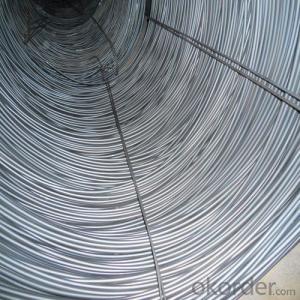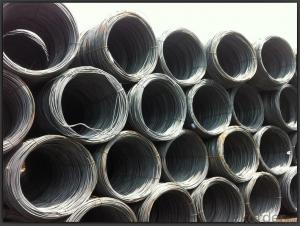6mm hot rolled low carbon 1008B steel wire coil/steel wire rod
- Loading Port:
- Tianjin
- Payment Terms:
- TT OR LC
- Min Order Qty:
- 500 m.t.
- Supply Capability:
- 1000000 m.t./month
OKorder Service Pledge
OKorder Financial Service
You Might Also Like
1. Introduction:
| Standard: | AISI, ASTM, SGS | Grade: | 400 Series | Wire Gauge: | 6mm |
| Length: | M | Application: | construction | Certification: | SGS |
| C Content (%): | 0.03~O.07 | Si Content (%): | ≤0.30 | Place of Origin: | Shandong, China (Mainland) |
| Brand Name: | Xindadi | Model Number: | 6mm | diameter: | 5.5-10mm |
| Steel Grade: | SAE1008B | application: | construction | coil weight: | 1.8-2.1ton |
| Tensile strength: | 350-380 | Elongation: | ≥32 | Yield strength: | 250-280 |
Packaging & Delivery
| Packaging Details: | industrial package or according to customer's requirements |
| Delivery Detail: | valid in 10 days |
2. Specifications:
Name | 6mm hot rolled low carbon 1008B steel wire coil/steel wire rod |
Standard | GB, SAE, SGS, ASTM |
Diameter | 6mm |
Coil weight | 1.8-2.1tons |
MOQ | 40tons |
Deliver Time | 15 days after receipt of L/C or deposit by T/T |
Packing | In coil and load in container, if large quantity, by bulk vessel; can be packed as customers' special requirements |
Payment terms | 1).100% irrevocable L/C at sight.2).30% T/T prepaid and the balance against the copy of B/L.3).30% T/T prepaid and the balance against L/C |
Application | Building material, machinery parts |
3.Application:
Applicationwidely used in machinery parts, manufacturing industry, electronics industry, metal tools and others
4. Pictures
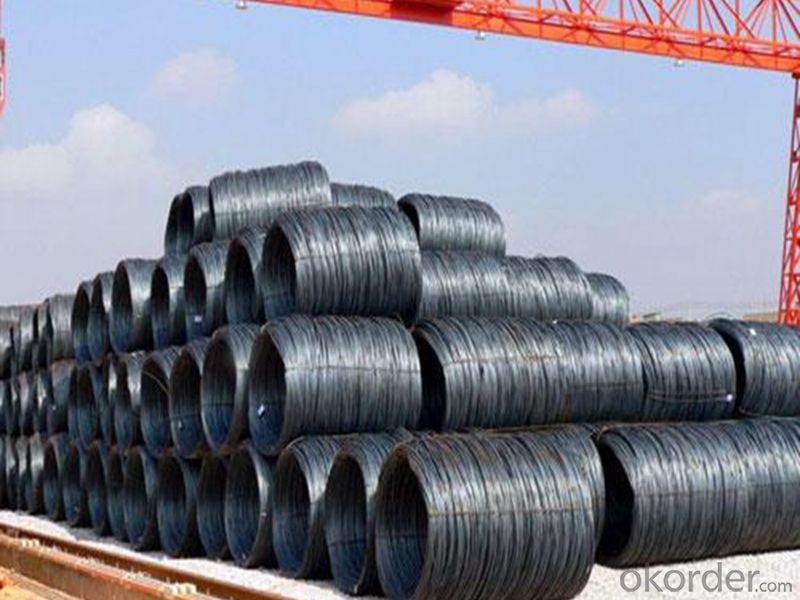
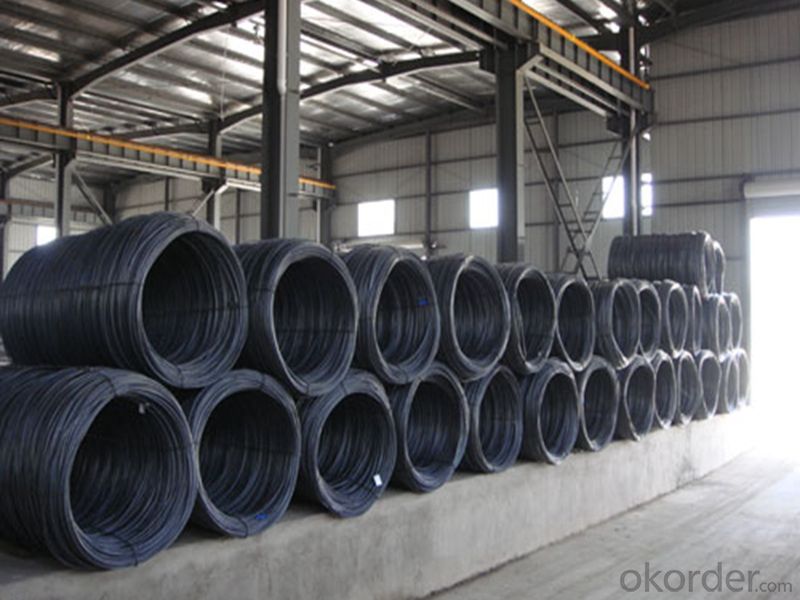
5.FAQ
We have organized several common questions for our clients,may help you sincerely:
①How about your company?
A world class manufacturer & supplier of castings forging in carbon steel and alloy steel,is one of the large-scale professional investment casting production bases in China,consisting of both casting foundry forging and machining factory. Annually more than 8000 tons Precision casting and forging parts are exported to markets in Europe,America and Japan. OEM casting and forging service available according to customer’s requirement.
②How to guarantee the quality of the products?
We have established the international advanced quality management system,every link from raw material to final product we have strict quality test;
- Q: What are the different testing standards for steel wire rod?
- There are several testing standards for steel wire rod, including ASTM A510, ASTM A370, ASTM E8/E8M, ASTM E290, and ISO 6892-1. These standards outline various mechanical and physical tests to evaluate the quality, strength, and other properties of steel wire rod, such as tensile strength, yield strength, elongation, hardness, and chemical composition.
- Q: Can steel wire rod be used in the production of automotive parts?
- Yes, steel wire rod can be used in the production of automotive parts. It is commonly used to manufacture various components such as springs, cables, and reinforcements due to its high strength and durability.
- Q: What are the main factors affecting the market expansion of steel wire rod?
- The main factors affecting the market expansion of steel wire rod include demand from various industries such as automotive, construction, and infrastructure, as well as economic growth and industrialization in emerging markets. Additionally, factors such as government policies, technological advancements, and competitive pricing also play a significant role in driving the market expansion of steel wire rod.
- Q: How is steel wire rod used in the production of cold-formed steel sections?
- Steel wire rod is used in the production of cold-formed steel sections as it serves as the primary raw material for these sections. The wire rod is typically formed and shaped through a cold-forming process, where it is bent, twisted, or rolled into the desired shape and dimensions. This allows manufacturers to produce a wide range of cold-formed steel sections, such as channels, angles, and beams, which are commonly used in construction, automotive, and manufacturing industries. The high strength and durability of steel wire rod make it an ideal material for cold-formed steel sections, ensuring structural integrity and reliability in various applications.
- Q: How is the microstructure of steel wire rod analyzed?
- The microstructure of steel wire rod is typically analyzed using various techniques such as optical microscopy, electron microscopy (scanning electron microscopy or transmission electron microscopy), and X-ray diffraction. These techniques allow for the examination of the grain structure, inclusion content, and other microstructural features of the steel wire rod.
- Q: What are the main growth drivers for the steel wire rod market?
- The steel wire rod market is driven by several key factors. Firstly, the construction industry plays a crucial role in driving demand for steel wire rods. These rods are extensively used in various construction applications, such as reinforcing concrete structures, building fences, and constructing suspension bridges. Given the ongoing urbanization and infrastructure development worldwide, the construction sector's demand for steel wire rods is anticipated to experience significant growth. Secondly, the automotive industry serves as another major driver for the steel wire rod market. Steel wire rods are essential in manufacturing automobile parts, including springs, tires, and suspension systems. As the automotive industry continues to expand globally, particularly in emerging markets, the demand for steel wire rods will inevitably increase to meet the rising production needs. Additionally, the energy sector also contributes to the growth of the steel wire rod market. Steel wire rods are vital in producing electrical cables, power transmission lines, and oil and gas pipelines. With the global demand for energy steadily increasing, there will be a higher requirement for steel wire rods to support the infrastructure necessary for energy production and distribution. Furthermore, the growing demand for consumer goods, such as electronics and appliances, plays a significant role in driving the steel wire rod market. These rods are used in manufacturing various consumer goods, including kitchen appliances, furniture, and electronic devices. As consumer spending rises and new markets emerge, the demand for steel wire rods in the consumer goods sector is expected to witness a notable surge. Lastly, technological advancements and innovations in steel manufacturing processes are propelling the growth of the steel wire rod market. These advancements have led to the production of high-quality steel wire rods with enhanced strength and durability, making them highly desirable for various applications. Additionally, the development of advanced machinery and equipment for steel wire rod production has improved efficiency and reduced production costs, further bolstering market growth. In conclusion, the primary drivers for the steel wire rod market encompass the construction industry, automotive industry, energy sector, demand for consumer goods, and technological advancements. As these industries continue to expand and evolve, the demand for steel wire rods is projected to rise, thereby stimulating market growth.
- Q: What are the different packaging materials used for steel wire rod?
- There are several different packaging materials commonly used for steel wire rods. These materials are chosen based on factors such as the length and weight of the wire rods, the level of protection required during transportation, and the ease of handling for both the manufacturer and the end user. Here are some of the most commonly used packaging materials for steel wire rods: 1. Steel Coils: One of the most popular packaging options for steel wire rods is to bundle them into coils. The wire rods are wound tightly into a coil shape using a winding machine. This method provides a compact and secure packaging solution, making it easy to transport and handle the wire rods. 2. Wooden Reels: For longer and heavier wire rods, wooden reels are often used. The wire rods are wound around a wooden reel, providing a larger and more stable packaging option. Wooden reels are commonly used for wire rods that are used in construction and industrial applications. 3. Pallets: Another packaging option for steel wire rods is to stack them on wooden or plastic pallets. This method provides a stable base for the wire rods and allows for easy handling using forklifts or pallet jacks. Pallets are commonly used for bulk shipments of wire rods. 4. Cardboard Boxes: Smaller wire rods or wire rods with specific length requirements may be packaged in cardboard boxes. These boxes provide protection against damage during transportation and allow for easy handling and storage. 5. Plastic Wraps: In some cases, steel wire rods may be packaged using plastic wraps. This method is often used for smaller quantities or when the wire rods need to be protected from moisture or dust during transportation. It is important to note that the choice of packaging material may vary depending on the specific requirements of the wire rod manufacturer and the end user. Factors such as cost, transportation method, and storage conditions can also influence the selection of packaging materials.
- Q: What are the main factors influencing the choice of steel wire rod order product testing options?
- The main factors influencing the choice of steel wire rod order product testing options include customer requirements, industry standards and regulations, quality control considerations, and the intended use of the wire rod.
- Q: What are the common industry trends for steel wire rod?
- Some common industry trends for steel wire rod include increasing demand from the construction and automotive sectors, advancements in technology leading to improved product quality and efficiency, growing emphasis on sustainability and recycling practices, and the emergence of new markets and applications for steel wire rod products.
- Q: What are the major opportunities for companies in the steel wire rod market?
- Some major opportunities for companies in the steel wire rod market include expanding into emerging economies with growing construction and infrastructure sectors, diversifying product offerings to cater to various industries such as automotive and aerospace, embracing technological advancements to improve production efficiency and quality, and exploring sustainable practices to meet the growing demand for environmentally friendly steel products.
Send your message to us
6mm hot rolled low carbon 1008B steel wire coil/steel wire rod
- Loading Port:
- Tianjin
- Payment Terms:
- TT OR LC
- Min Order Qty:
- 500 m.t.
- Supply Capability:
- 1000000 m.t./month
OKorder Service Pledge
OKorder Financial Service
Similar products
Hot products
Hot Searches
Related keywords
